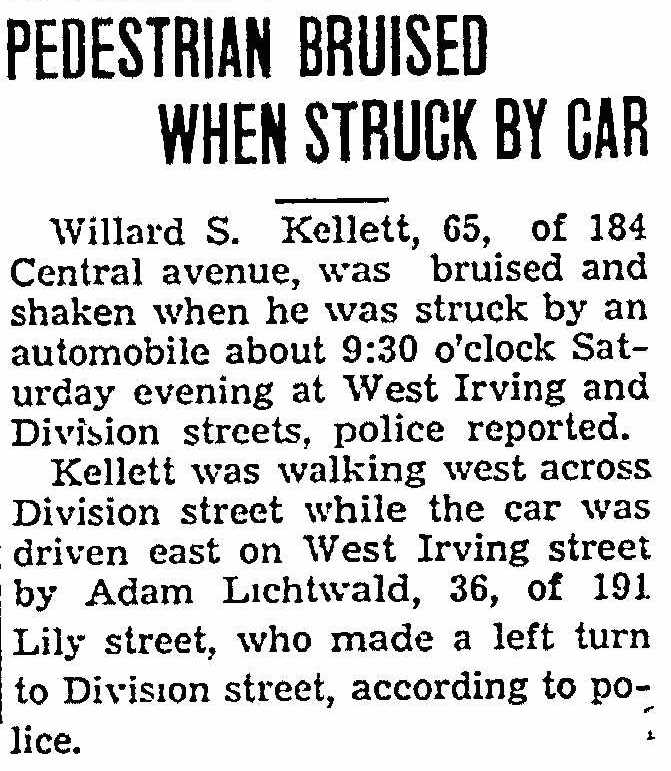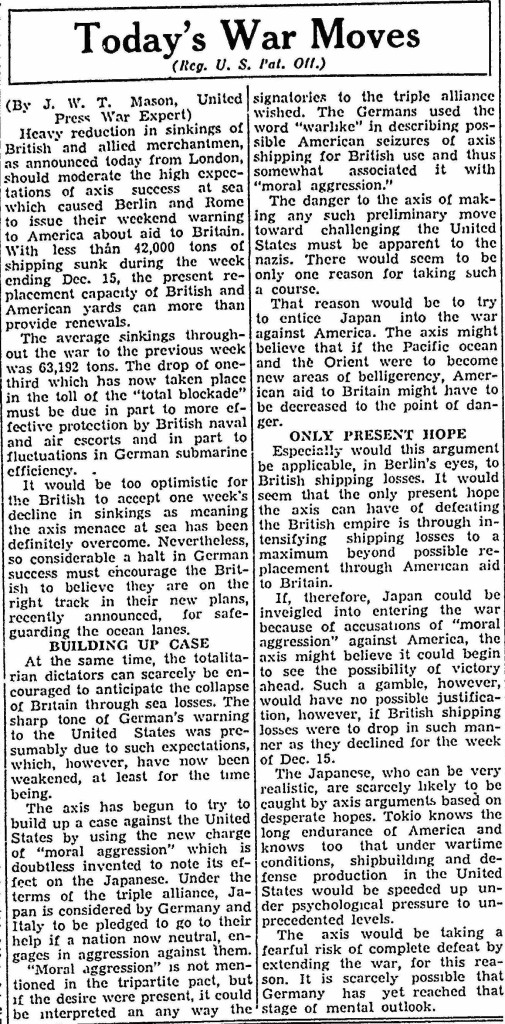[found by Lynn C. Rees]
Searching for items on Willard Sidney Kellett (1876-1962), my second cousin twice removed, I found this story in the Oshkosh Daily Northwestern, dateline December 23, 1940:

My eyes drifted to this story on another bruising collision, found on the same page:

UPI war expert Mason was a member of that generation of Americans who elevated this nation to global numero uno, displacing the decrepit Old Enemy:
J. W. T. (Joseph Warren Teets) Mason (1879-1941) was an American who devoted himself to the study of Eastern philosophy and religion. Born on January 3, 1879 in Newburgh, New York, Mason graduated from New York University and decided to become a journalist to follow in his father’s footstep[s]. He worked for the Scripps McRae Press Association as its London Editor, and when the company merged into the United Press Associations in 1907, he became the European Manager. A year after the appointment at the United Press, however, he resigned from the post and returned to the United States. In the following years, he worked for the Daily Express as the New York Editor (1908-1931), specifically as the war writer during the World War I. After the War, he also worked for the United Press as the foreign affairs writer (1918-30). While he was in Europe on his job, he became acquainted with famous philosophers, such as Henri Bergson, Benedetto Croce, and F. C. S. Schiller. He also met Japanese diplomats Suematsu Kenshu and Hayashi Gonsuke, who introduced him to Japanese Shinto, the native religion of Japan, and Confucianism. His interest in Eastern civilization grew, and he published two books, Creative East (1926) in New York and Creative Freedom (1928) in London.
Although he had been already acquainted with many Japanese officials, scholars, and priests both in and out of Japan, a visit to Japan was not realized until 1932. During his stay in Japan, he attended many Shinto ceremonies and lectured on Japanese religions and cultures all over in Japan. He published Kaminagara no michi (1933) (English language edition, The Meaning of Shinto, was published in New York in 1935) and The Spirit of Shinto Mythology (1939) in Tokyo. He was a member of many associations including the Meiji Japan Society, the Asiatic Society of Japan, and the Kyoto Buddhist Association. Although the year he departed Japan is unknown, he died in New York on May 13, 1941.
Mason, whose death preceded Pearl Harbor by seven months, accurately forecasts factors that led to later “axis” defeat:
- “long endurance of America”? Check.
- “shipbuilding and defense production” sped up in wartime by “psychological pressure to unprecedented levels”? Check.
- “fearful risk of complete defeat by extending the war”? Check.
Mason’s forecast is overly generous to “Tokio”. It claims it’s “scarcely” possible that Japan could be drawn into war by “axis arguments based on desperate hopes”. Mason’s forecast is equally overly generous to Berlin in claiming it’s “scarcely” likely it had reached a “state of mental outlook” that would lead to war with the United States. Mason’s working definition of “scarcely” seems to equal one year, plus or minus a few weeks.
It wouldn’t surprise me if Mason’s Japanese acquaintances were among those Japanese who “can be realistic”. Americans often see foreign things through interlocutor eyes with enough shared tics to completely veil the alien. However, Mason’s qualified use of can reflects some awareness that the Japanese did not have to be realistic, at least according to Masonic definitions rooted in American notions of what is realistic under conditions of scarcely. Some Japanese knew that Japan’s chances of victory in a Materialschlacht with the reigning Master of More were materially non-existent. Cue ominous music, background to yet another seemingly prophetic incantation of Yamamoto Isoroku’s supposed quote.
Yamamoto’s supposed compliment is popular in this country, land of the “sleeping giant”. It’s a meditation on our own awesomeness, like listening to the sound of one back slapping. This sketchy acknowledgment impressed some later Americans so much that they sometimes elevate Yamamoto to honorary American, in consciousness if not de jure. Yamamoto was a reverse Mason: he spent time in America. He must have known he would lose as far back as 1919. Tojo and friends must be blockheads if they don’t listen to their Yamamotos and preemptively surrender to American awesomeness.
But some foreign observers were realists even by Masonic standards. They saw American “moral aggression”, felt its potency, and saw that their only realistic counter was to scale up to American economies of scale, even if the scaling up was a gamble on the sleeping giant staying asleep while they carved out American beating lebensraums out of some promising part of Eurasia. Adam Tooze has argued that, after 1916, American power was so overwhelming that other global polities that aspired to greatness were de facto international insurgents against American dominion and its Masons. A Japanese “who can be very realistic” was someone like Lt. Col. Kanji Ishiwara, Imperial Japanese Army. He gambled that Japan could carve its American beating lebensraum out of China, allowing teeny Japan to materially go toe to toe with the American colossus before the colossus scarcely knew what hit it. Ishiwara gambled, a gamble that fathered a cascade of gambles toppling towards Hiroshima.
For Ishiwara, there had to be a shortage of Masons that could see what he or his German mentors were up to as they tried lebensrauming Eurasia if his gamble was to succeed. Unfortunately for Ishiwara, there were enough Masons, some even deigning to write columns read in Oshkosh, Wisconsin and other outposts of America’s trend-setting lebensraum, to frustrate Ishiwaran insurgents of the mid-20th century. These Masons of a new order knew what was up with Ishiwara and ilk. This made Ishiwaran projects unrealistic. For Ishiwara and friends, nemesis was spelled Willard Sidney Kellett: they were cruising for his bruising.




